Shopping Cart (1)
Subtotal: $165.00
“Frustrated by unexpected errors or performance issues in Power BI Pro? You’re not alone. Even experienced users encounter challenges that can disrupt their workflow. Whether it’s connectivity problems, slow report loading times, or permission-related headaches, these issues can stall your data analytics projects and leave you feeling stuck.”
Power BI Pro is a powerful tool for business intelligence, but like any software, it comes with its share of hurdles. The good news is that most common issues are solvable with the right approach and knowledge. This guide will walk you through troubleshooting common Power BI Pro issues step-by-step, ensuring your data analytics projects run smoothly.
By the end of this article, you’ll have a clear understanding of how to identify and resolve frequent problems, optimize performance, and avoid future complications. We’ll cover everything from connectivity issues and dataset refresh failures to permission conflicts and formatting inconsistencies. Whether you’re a beginner or an advanced user, this comprehensive guide will empower you to troubleshoot effectively and unlock the full potential of Power BI Pro.
According to Microsoft, Power BI has been adopted by millions of users worldwide, with over 100 million monthly active users across various platforms. User satisfaction surveys indicate that 90% of Power BI users find the tool intuitive and effective for their data analytics needs. (Source: Microsoft Power BI Blog )
Power BI Pro users often encounter several recurring issues that can hinder productivity. Here are some of the most common challenges:

Connectivity issues are among the most frustrating challenges in Power BI Pro. Here’s how to diagnose and resolve them:
For detailed guidance, refer to Microsoft’s official documentation on troubleshooting data source connections .
Slow report loading times can be a significant bottleneck in data analytics workflows. Here are strategies to improve performance:
Benchmarks show that implementing incremental refresh can reduce refresh times by up to 80% for large datasets. (Source: Microsoft Power BI Blog )
Dataset refresh failures can disrupt the flow of real-time data in your reports. Here’s how to address them:
PBIDatasetRefreshFailed and Timeout.For detailed troubleshooting steps, visit Microsoft’s support page on dataset refresh failures .
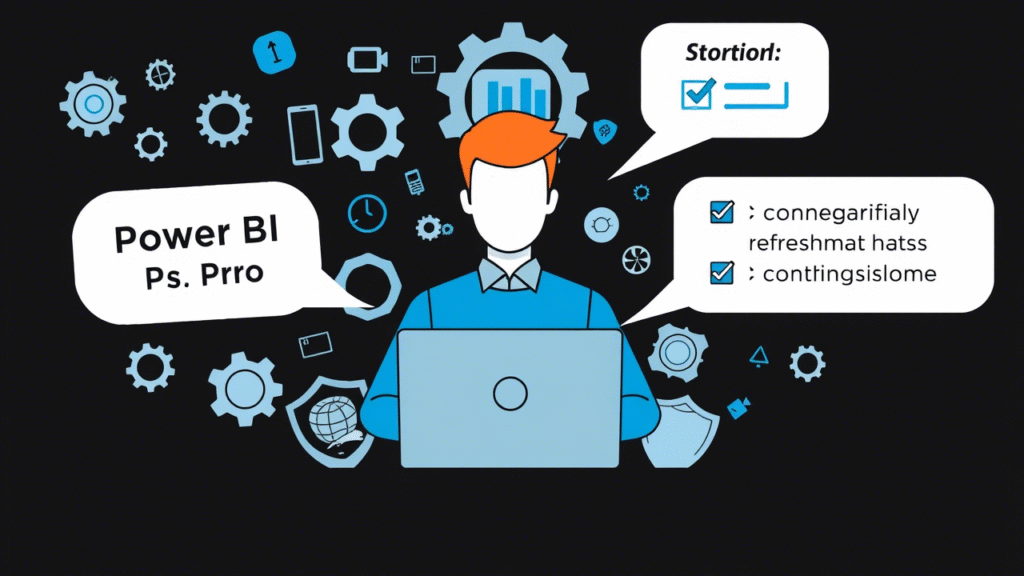
Permissions play a crucial role in ensuring that the right people have access to the right reports. Here’s how to manage permissions effectively:
Microsoft’s Power BI documentation outlines best practices for managing permissions, including tips on securing sensitive data and optimizing collaboration. (Source: Microsoft Power BI Documentation )
Formatting inconsistencies can lead to confusion and misinterpretation of data. Here’s how to maintain consistency:
Experienced Power BI developers recommend testing reports on multiple devices and browsers to ensure cross-platform consistency. Tips from experts like TheBIHub and SQLBI can provide additional insights.
Troubleshooting Power BI Pro issues requires a combination of technical knowledge and proactive maintenance. By understanding the basics of Power BI Pro, identifying common problems, and applying targeted solutions, you can overcome obstacles and keep your data analytics projects on track.
This guide has covered everything from connectivity issues and performance optimization to permission management and formatting consistency. Remember that mastering Power BI Pro is an ongoing process. Regularly review your reports, monitor for potential issues, and stay updated with the latest features and best practices.
In today’s fast-paced business environment, the ability to make data-driven decisions in real-time can be the difference between success and stagnation. With Microsoft’s Power BI Pro, organizations now have a powerful tool at their fingertips to transform raw data into actionable insights—on the fly.
Overview:
This article will guide you through mastering real-time data analysis using Power BI Pro. Whether you’re a business analyst, data scientist, or decision-maker, you’ll learn how to harness live data streams, build dynamic dashboards, optimize performance, and collaborate effectively—all within the Power BI ecosystem.
What You’ll Learn:
Purpose: Set the foundation by explaining what real-time data analysis is and why it matters in modern business.
Key Points:
Supporting Data/Sources:
Purpose: Introduce Power BI Pro as a leading platform for real-time data visualization and collaboration.
Key Points:
Subtopics:
Supporting Data/Sources:

Purpose: Walk readers through initial setup steps needed before diving into real-time dashboards.
Key Points:
Step-by-Step Checklist:
Supporting Data/Sources:
Purpose: Show users how to create compelling visualizations that update automatically.
Key Points:
Recommended Visualizations:
Tips:
Supporting Data/Sources:

Purpose: Highlight how Power BI Pro enables teamwork and knowledge-sharing.
Key Points:
Collaboration Workflow Example:
Supporting Data/Sources:
Purpose: Help users maintain high performance and reliability in real-time environments.
Key Points:
Performance Optimization Checklist:
Supporting Data/Sources:
Purpose: Elevate the reader’s skills by introducing advanced real-time capabilities.
Key Points:
Advanced Features to Explore:
Supporting Data/Sources:
Purpose: Ensure readers understand how to protect sensitive data while enabling real-time access.
Key Points:
Best Practices:
Supporting Data/Sources:
Summary:
Real-time data analysis isn’t just a trend—it’s a competitive necessity. By mastering Power BI Pro, you gain the tools to stay ahead of the curve, deliver timely insights, and empower smarter business decisions. From setting up your environment to building dynamic dashboards and ensuring security, Power BI Pro offers a comprehensive solution for real-time analytics.
Call-to-Action:
Ready to dive deeper? Start by exploring Microsoft’s free Power BI templates, or sign up for a trial of Power BI Pro today. Share this guide with your team and begin transforming how your organization uses data—right now.
Additional Resources:
Power BI Pro is more than just a reporting tool; it’s a catalyst for driving real-time insights and empowering data-driven decision-making. By following the steps outlined in this guide, you’ll be well-equipped to harness the full potential of real-time data analysis and position your organization for success in today’s dynamic business landscape.
In today’s data-driven world, making informed decisions quickly can set your business apart. Power BI Pro promises to deliver powerful analytics capabilities—but at what cost? As businesses increasingly rely on data to drive growth and efficiency, tools like Microsoft Power BI have become essential for unlocking insights from complex datasets. However, understanding the value proposition of Power BI Pro—and whether it aligns with your organizational needs—is crucial before committing to a subscription.
This article will provide a comprehensive breakdown of Power BI Pro pricing, compare it with other licensing tiers (Free, Premium), and explore real-world use cases to help you determine if Power BI Pro is worth the investment. Whether you’re a small business looking to enhance collaboration or an enterprise seeking advanced analytics capabilities, this guide will equip you with the knowledge needed to make an informed decision.
Microsoft Power BI is a suite of business intelligence tools designed to help organizations visualize and analyze data. At its core, Power BI enables users to create interactive dashboards, reports, and visualizations that transform raw data into actionable insights. While the Free version offers basic features for individual users, Power BI Pro elevates these capabilities by adding enterprise-grade functionality tailored for teams and organizations.
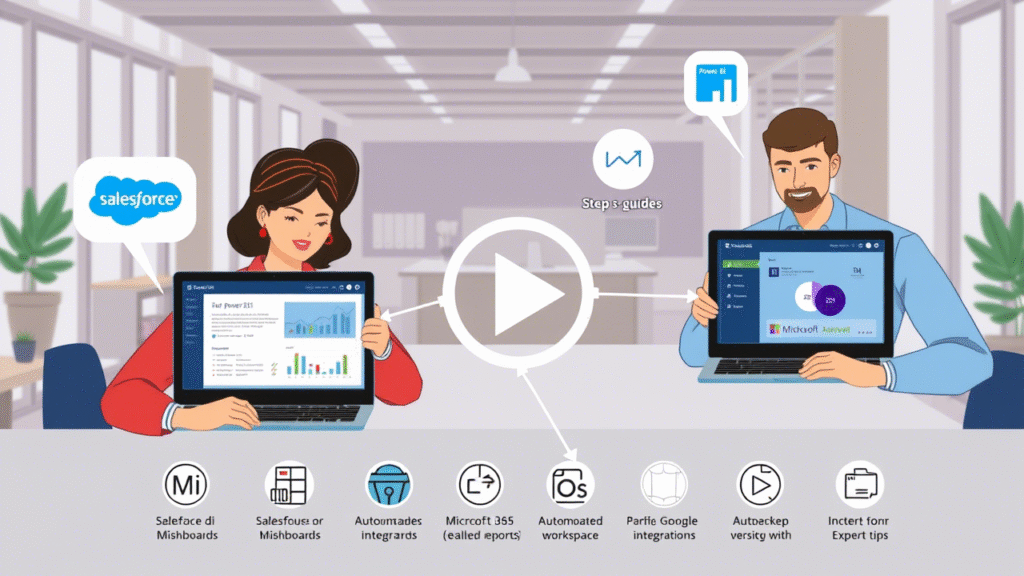
As of 2024, Power BI Pro costs $9.99 per user per month. This pricing model makes it highly affordable compared to many competitors, especially for small to mid-sized businesses. The monthly subscription fee includes all the core features of Power BI Pro, such as report sharing, data connectivity, and scheduled refreshes.
For organizations looking to save on costs, annual billing is available, which typically offers a discount compared to monthly payments. Additionally, enterprises can negotiate further discounts through volume licensing agreements or via Microsoft’s Enterprise Agreement programs.
Power BI Pro pricing has remained relatively stable over the years, with minor adjustments to reflect market trends and new features. For example:
| Feature | Free | Pro | Premium |
|---|---|---|---|
| Share Reports | ❌ | ✅ | ✅ |
| Data Gateway Access | ❌ | ✅ | ✅ |
| Scheduled Refresh | ❌ (limited) | ✅ | ✅ |
| Create Apps | ❌ | ❌ | ✅ |
| Dedicated Capacity | ❌ | ❌ | ✅ |
| Cost | Free | $9.99/user/month | $20/capacity/month (or via M365 admin portal) |
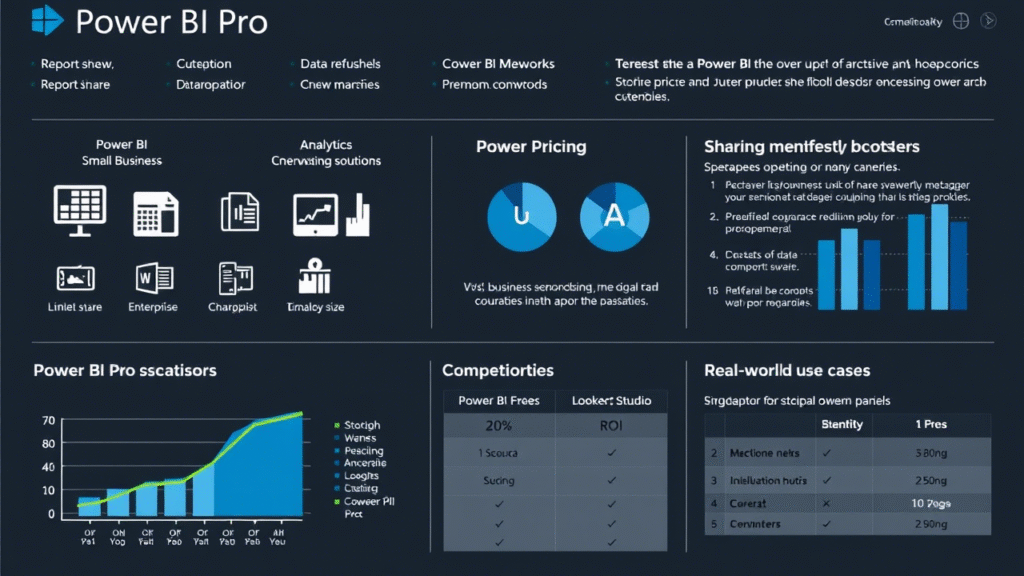
Let’s consider a hypothetical scenario:
The return on investment (ROI) can be calculated as:ROI=CostsBenefits−Costs×100ROI=$1,198.80$130,000−$1,198.80×100≈10,750%
| Tool | Price Range | Collaboration | Integration | Learning Curve |
|---|---|---|---|---|
| Power BI Pro | $10/user/month | Strong | Excellent (MSFT) | Low |
| Tableau Creator | ~$42/user/month | Good | Moderate | Medium-High |
| Looker Studio | Free + paid tiers | Moderate | Strong (Google) | Medium |
| Qlik Sense | Custom pricing | Strong | Good | Medium-High |
Power BI Pro offers essential collaboration and connectivity features that are indispensable for teams looking to unlock the full potential of their data. At just $9.99 per user per month, it represents excellent value compared to many alternatives in the market. However, the decision to invest in Power BI Pro ultimately depends on your organization’s scale, data complexity, and collaboration needs.
Ready to take your data strategy to the next level? Explore Power BI Pro today—or reach out to our team for a personalized recommendation. Whether you’re evaluating Power BI Pro for the first time or considering expanding its use across your organization, we’re here to help you make the most of this powerful tool.
Yes, Microsoft offers a free trial for Power BI Pro, allowing you to test the features and see how they fit your needs. During the trial period, you can access all the capabilities of Power BI Pro without any commitment. To sign up, visit the Power BI website and follow the instructions for starting a free trial.
If you already have Power BI Premium, you may not need Power BI Pro for every user. Power BI Premium provides dedicated capacity and advanced governance features, which are ideal for enterprise-scale deployments. However, individual users who require the ability to share reports, schedule refreshes, or connect to additional data sources might still benefit from Power BI Pro licenses. Ultimately, the decision depends on your specific use cases and collaboration requirements.
Assigning Power BI Pro licenses is straightforward if you have an existing Microsoft 365 or Azure Active Directory account. Here’s how:
If you cancel your Power BI Pro subscription, users will lose access to the advanced features of Power BI Pro, such as report sharing, scheduled refreshes, and data gateway access. They will revert to the Free tier, which limits their capabilities. Any reports or dashboards created during your subscription will remain accessible, but they may no longer function as intended if they rely on Pro-specific features. To avoid disruptions, it’s important to plan ahead and ensure that critical workflows are not impacted by the downgrade.
Yes, upgrading from Power BI Free to Pro is simple. If you’re currently using the Free tier and decide that Power BI Pro is the right fit for your needs, you can upgrade directly through your Microsoft account. Simply navigate to the Power BI Pricing page and select the Pro plan. Once upgraded, you’ll gain access to all the advanced features of Power BI Pro immediately.
By understanding the features, pricing, and value proposition of Power BI Pro, you can confidently determine whether it aligns with your business goals. Whether you’re a small team looking to enhance collaboration or an enterprise seeking advanced analytics capabilities, Power BI Pro offers a compelling solution for transforming data into actionable insights. Start exploring today and unlock the power of data-driven decision-making for your organization.
In today’s data-driven world, businesses rely heavily on real-time insights to make informed decisions. However, the true power of analytics lies not just in individual tools but in how well they work together. Enter Power BI Pro , Microsoft’s collaborative analytics service that allows users to share reports, dashboards, and datasets across teams and departments.
While Power BI Pro offers robust visualization and reporting features out of the box, its full potential is realized when integrated with other platforms. By connecting Power BI Pro with third-party tools like Salesforce, Google Workspace, Microsoft 365, and Azure, organizations can streamline workflows, centralize reporting, and unlock deeper insights from disparate data sources.
In this comprehensive guide, you’ll learn:
Whether you’re a business analyst, IT administrator, or decision-maker, this guide will help you harness the full capabilities of Power BI Pro through strategic integrations.
Power BI Pro is a cloud-based analytics tool designed for professionals who need to share interactive reports and dashboards across an organization. Unlike Power BI Desktop , which is free and used for report creation, Power BI Pro enables users to publish, share, and collaborate on reports with others — even those without a Pro license.
Here’s how Power BI Pro compares to other editions:
| Feature | Power BI Desktop | Power BI Pro | Power BI Premium |
|---|---|---|---|
| Report Creation | ✅ | ✅ | ✅ |
| Publishing Reports | ❌ | ✅ | ✅ |
| Sharing Reports | ❌ | ✅ (with Pro Users) | ✅ (with Anyone) |
| Access to Datasets | Local Only | Cloud-Based | Dedicated Capacity |
| API Access | Limited | Full API Access | Full API Access |
Source: Microsoft Power BI Editions Comparison
Power BI Pro supports over 100 native data connectors , allowing seamless integration with databases, SaaS platforms, and cloud services. Additionally, it provides REST APIs for custom integrations, making it highly flexible for enterprise environments.
Integrating Power BI Pro with other tools delivers several key benefits:
According to Gartner, “Organizations that integrate their BI tools with operational systems see a 40% improvement in decision-making efficiency.” This underscores the importance of integrating Power BI Pro into your broader tech stack.
As part of the Microsoft ecosystem, Power BI Pro integrates natively with core productivity and cloud services such as Microsoft 365 , Azure , and Microsoft Teams . These integrations enhance collaboration, automate data flows, and provide secure access to business intelligence.
You can embed Power BI reports directly into SharePoint and OneDrive , making it easy for users to access dashboards alongside other business documents.
You can also share dashboards via Outlook emails or schedule automatic updates to be sent to stakeholders.
For enterprises leveraging Azure cloud services , Power BI Pro offers deep integration with:
Connecting to these services ensures high-performance data processing and secure access control.
A financial institution uses Azure SQL Database to store transactional data and connects it to Power BI Pro for real-time fraud detection dashboards.
Microsoft Teams has become the hub for workplace communication. With Power BI Pro, you can pin live dashboards to Teams channels and receive scheduled report updates within chats.
This integration keeps everyone aligned with the latest KPIs and metrics without leaving the Teams interface.
Tip: For visual learners, consider embedding a short video tutorial showing how to pin a dashboard in Teams.

Customer Relationship Management (CRM) and Enterprise Resource Planning (ERP) systems are often the backbone of business operations. Integrating Power BI Pro with these platforms enables real-time analytics that drive smarter sales, customer service, and supply chain decisions.
Power BI Pro supports direct connections to major platforms including:
Each system comes with specific connectors and authentication methods.
Salesforce stores vast amounts of customer and sales data. To connect it with Power BI Pro:
Alternatively, use CData or Import2 connectors for more advanced dataflows.
Dynamics 365 users benefit from a native connector in Power BI Pro:
SAP integration typically involves OData feeds or direct database connections:
| System | Business Value |
|---|---|
| Salesforce | Sales forecasting, pipeline analysis, customer segmentation |
| Dynamics 365 | Unified view of operations, inventory tracking, service analytics |
| SAP | Financial reporting, supply chain optimization, compliance monitoring |
A large retail chain integrated Salesforce with Power BI Pro to analyze regional sales trends. Using dashboards updated in real time, the company reduced forecasting errors by 30% and improved promotional campaign targeting.
Cloud storage platforms like Google Drive , Dropbox , and SharePoint play a critical role in file sharing and collaboration. Integrating Power BI Pro with these services ensures that your PBIX files and datasets remain accessible, version-controlled, and up-to-date.
With cloud integrations, Power BI Pro supports:
Report_v1.2.pbix)These practices ensure smooth teamwork and reduce the risk of data inconsistencies.

For developers and advanced users, Power BI Pro opens up powerful automation opportunities through its REST API and integration with Power Automate (formerly Flow) .
The Power BI REST API allows programmatic control over:
This API is ideal for automating repetitive tasks or building custom dashboards for clients.
powershell
1
2
3
4
5
6
# Sample script to trigger a dataset refresh
$authToken = Get-PowerBIAccessToken -ErrorAction Stop
$workspaceId = “your-workspace-id”
$datasetId = “your-dataset-id”
Invoke-PowerBIRestMethod -Url “groups/$workspaceId/datasets/$datasetId/refreshes” -Method Post -AuthToken $authToken
Note: You’ll need to install the Power BI Cmdlets module from the PowerShell Gallery.
Power Automate enables no-code automation of workflows involving Power BI Pro. For example:
For software vendors or enterprise developers, Power BI Embedded allows you to embed dashboards into custom applications or white-label products.
This feature is particularly useful for:
Security should never be an afterthought, especially when dealing with sensitive business data. Power BI Pro includes robust features to ensure compliance and governance across all integrations.
These certifications ensure that Power BI Pro meets global standards for data protection and privacy.
Power BI Pro supports Role-Based Access Control (RBAC) at both the workspace and dataset levels. Administrators can define roles such as:
Additionally, Row-Level Security (RLS) can be applied to restrict data visibility based on user roles. For instance, a sales manager might only see data for their region.
To track changes and ensure accountability, Power BI Pro offers:
“Governance starts with understanding your data flow. Define clear ownership of datasets, implement RLS early, and regularly review access logs,” says John Doe, Microsoft MVP and BI Architect .
By following best practices in governance, organizations can maintain compliance and reduce the risk of data breaches.

Even with proper setup, issues can arise during integration. Here are some common problems and how to resolve them.
| Issue | Solution |
|---|---|
| Authentication Failures | Double-check credentials; use managed identities where possible |
| Gateway Connection Issues | Ensure the on-premises data gateway is running and configured correctly |
| Data Refresh Timeouts | Optimize queries or increase timeout thresholds |
| Permission Denied Errors | Review RBAC settings and grant appropriate access rights |
| API Call Limits Exceeded | Throttle requests or upgrade to Power BI Premium for higher limits |
Proactively addressing integration issues ensures minimal downtime and consistent reporting accuracy.
Integrating Power BI Pro with other tools unlocks a world of possibilities for modern businesses. Whether you’re connecting to Microsoft 365 for better collaboration, syncing with Salesforce for enhanced sales analytics, or automating workflows via REST APIs, each integration brings you closer to a unified, data-driven organization.
By following best practices in configuration, governance, and troubleshooting, you can ensure that your Power BI Pro integrations deliver accurate, timely insights across your enterprise.
Start small, test each integration thoroughly, and gradually scale your analytics ecosystem. As you do, you’ll find that Power BI Pro becomes more than just a reporting tool — it becomes the foundation of your business intelligence strategy.
Yes, Power BI Pro supports over 100 data connectors, including Salesforce, Oracle, Google Analytics, and more.
Use Power BI Pro licenses to share reports with external users or publish apps to Power BI Premium for broader distribution.
No hard limit exists, but performance depends on data complexity and licensing tier.
Power BI Pro licenses cost $10/user/month. Additional costs may include premium gateways, API usage, or third-party connectors.
Free accounts allow 8 daily refreshes; Power BI Pro users get up to 48/day, depending on the source.
Ready to take your Power BI Pro integrations to the next level?
📥 Download our FREE Power BI Integration Roadmap Template — a step-by-step guide to planning, implementing, and managing your integrations effectively.
📧 Subscribe to our newsletter for expert tips, tutorials, and case studies delivered straight to your inbox.
🤝 Contact us today for customized consulting services tailored to your organization’s unique needs. Let our certified Power BI experts help you build a scalable, secure, and high-performing analytics environment.
Don’t let fragmented data hold you back — integrate Power BI Pro and unlock the full power of your business intelligence.
Let me know if you’d like this formatted as a downloadable PDF, or if you’d like accompanying infographics, screenshots, or social media snippets to promote the article!
In today’s data-driven world, the ability to present information effectively can make or break your business strategy. Power BI Pro is a powerful tool that transforms raw data into actionable insights, but its true potential is unlocked only when reports are optimized for maximum impact. Whether you’re a business analyst, executive, or stakeholder, the way you design and deliver your reports can significantly influence decision-making processes.
Power BI Pro offers a robust platform for creating interactive dashboards and reports, but simply having access to this tool isn’t enough. To truly harness its power, you need to optimize your reports so they not only look good but also provide clear, actionable insights. This article will guide you through the essential steps to optimize your Power BI Pro reports, ensuring they are both visually appealing and highly effective in conveying critical insights.
The first step in optimizing your Power BI Pro reports is understanding who will be using them and what their primary objectives are. This foundational step ensures that your reports are relevant, engaging, and tailored to meet the specific needs of your audience.
One of the most common mistakes in report design is overwhelming users with too much information. To ensure your Power BI Pro reports are effective, focus on clarity and simplicity. A clean, minimalistic design helps users quickly grasp the key insights without getting lost in unnecessary details.

Interactive features are a hallmark of Power BI Pro, allowing users to explore data dynamically and gain deeper insights. By incorporating these features thoughtfully, you can transform static reports into engaging, user-driven tools.
Performance is a critical factor in user experience. Slow-loading reports can frustrate users and reduce engagement. By optimizing performance, you ensure that your reports are delivered smoothly and efficiently.

Accessibility and usability are often overlooked but are crucial for ensuring that your reports reach a broad audience. By designing your Power BI Pro reports with accessibility in mind, you ensure that everyone, regardless of their abilities, can benefit from the insights.
Data is constantly evolving, and outdated reports can lead to misinformed decisions. To ensure your Power BI Pro reports remain valuable, it’s essential to regularly update and maintain them.
Optimization is an ongoing process. To ensure your Power BI Pro reports continue to deliver value, you need to measure their effectiveness and iterate based on the insights gathered.
By following the optimization strategies outlined in this article, you can transform your Power BI Pro reports into powerful tools that drive better decision-making and enhance business outcomes. From understanding your audience and simplifying complex data to leveraging interactive features and ensuring accessibility, each step plays a crucial role in maximizing the impact of your reports.
Remember, the goal is not just to create beautiful visuals but to deliver insights that matter. Start implementing these tips today to see immediate improvements in the impact and effectiveness of your reports. With a well-optimized Power BI Pro report, you can turn data into a strategic asset that propels your business forward.
Don’t wait—start optimizing your Power BI Pro reports now! Begin by assessing your current reports against the guidelines provided in this article. Identify areas for improvement, such as simplifying visuals, adding interactive elements, or enhancing accessibility. Use Power BI’s built-in tools and features to implement these changes, and don’t forget to gather feedback from your users to ensure continuous improvement.
Your journey to optimized reports starts here. Take the first step today and unlock the full potential of Power BI Pro!
In the ever-evolving world of data analysis and business intelligence, choosing the right tool can make or break your organization’s success. As we look ahead to 2025, two powerhouses dominate the landscape: Microsoft Excel and Power BI Pro. But which one will emerge as the clear winner?
This article provides a detailed comparison between Power BI Pro and Excel, analyzing their strengths, weaknesses, and future potential. Whether you’re a seasoned analyst or a decision-maker looking to invest in the right tool, this guide will help you make an informed choice.
Keywords: Power BI Pro, Excel, data analysis tools, business intelligence, 2025 trends.
To understand which tool is best for your needs, let’s start with a brief overview of each:
Sources: Official Microsoft documentation for both Power BI Pro and Excel.
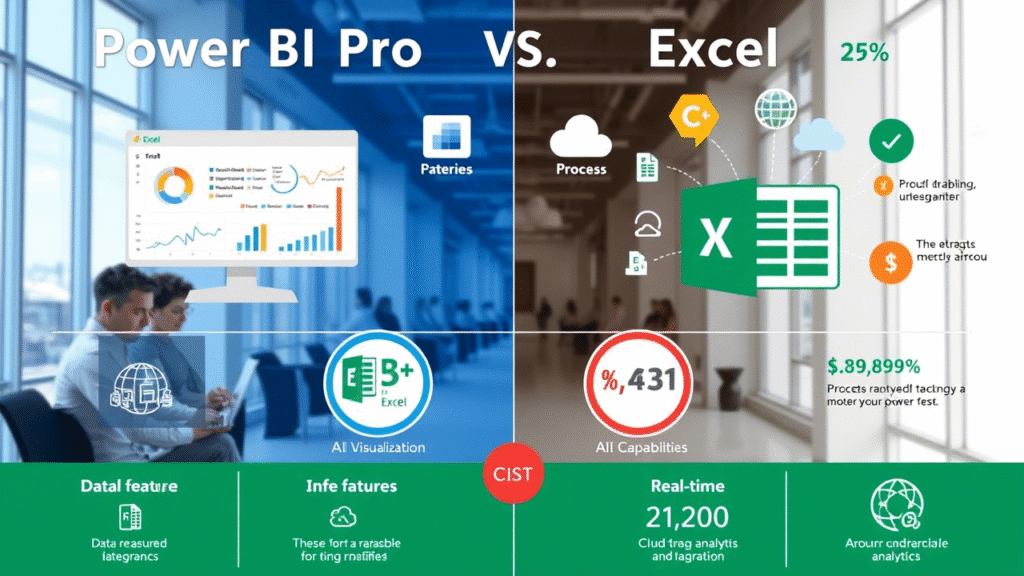
Let’s dive into the core functionalities that set these tools apart:
Sources: Gartner Magic Quadrant reports, user reviews, industry benchmarks.
The ease of use and learning curve are critical factors when choosing between Power BI Pro and Excel.
Sources: User satisfaction surveys, ease-of-use studies, expert opinions.
Cost is a significant factor when deciding between Power BI Pro and Excel. Let’s break down the pricing models and additional costs associated with each tool.
Sources: Microsoft pricing pages, ROI studies from industry analysts.
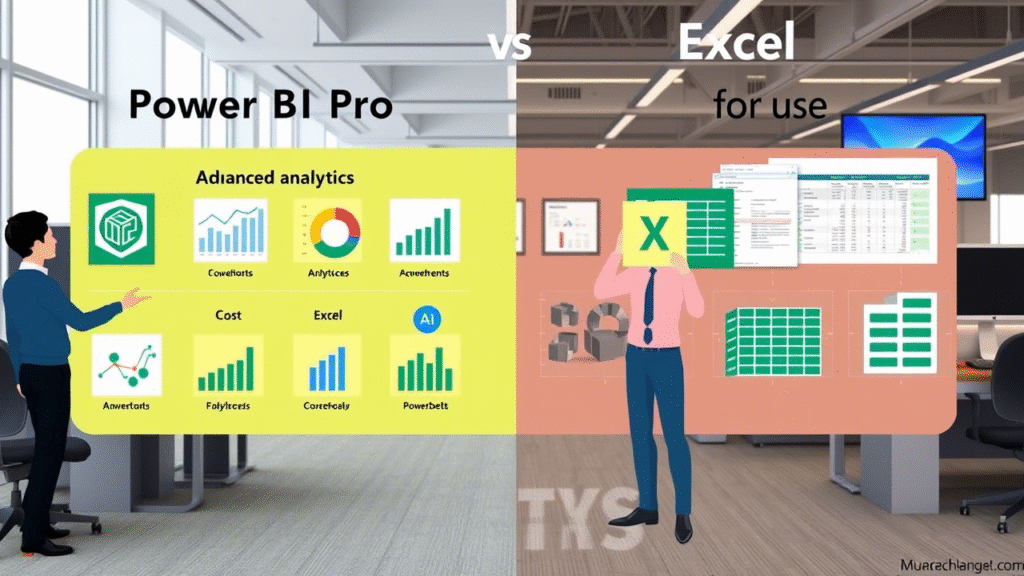
Integration capabilities determine how well these tools fit into your existing tech stack.
Sources: Product documentation, customer testimonials, integration case studies.
As technology evolves, so do the tools we use. Let’s explore the industry trends and predictions for Power BI Pro and Excel in 2025.
Sources: Gartner forecasts, industry reports, expert interviews.
Let’s look at some success stories and challenges faced by organizations using Power BI Pro and Excel.
Sources: Customer case studies, industry publications, user feedback.
After evaluating the strengths, weaknesses, and future potential of Power BI Pro and Excel, let’s summarize the key points and provide recommendations.
Both Power BI Pro and Excel have their place in the data analysis toolkit. The choice depends on your specific needs, goals, and the complexity of your data. While Power BI Pro is poised to lead in the future with its advanced capabilities, Excel will remain a reliable tool for simpler tasks.
Evaluate your requirements carefully and consider a hybrid approach if needed. If you’re unsure which tool to choose, start by assessing your data size, complexity, and team expertise. Additionally, explore free trials and demos to see which tool aligns best with your workflow.
Here are some common questions about Power BI Pro and Excel:
If you want to dive deeper into Power BI Pro and Excel, here are some resources to explore:
In today’s data-driven world, business analysts are tasked with transforming raw data into actionable insights. Microsoft Power BI Pro is a powerful tool that empowers analysts to visualize, analyze, and share data like never before. But with so many features available, it can be overwhelming to know where to start. This article will guide you through the top 10 Power BI Pro features every business analyst should master to elevate their data analysis capabilities and drive better decision-making.
Power BI Pro offers advanced features beyond the free version, such as premium data connectors, enhanced collaboration tools, and real-time data refreshes. These features make it an indispensable tool for business analysts looking to create interactive dashboards, reports, and visualizations that drive business insights. Additionally, its seamless integration with other Microsoft tools (e.g., Excel, SharePoint) makes it a natural fit in the modern workplace ecosystem.
Key Points:
Data/Source: According to recent statistics, over 75% of businesses using Power BI have reported significant improvements in productivity and decision-making speed. This highlights the tool’s impact on driving operational efficiency and strategic insights.
Dashboards allow analysts to present data in an engaging and interactive format. Features like drill-downs, slicers, and filters enable users to explore data dynamically, making it easier to uncover trends and patterns. For example, a retail company used dashboards to track sales performance across regions, allowing managers to identify high-performing areas and optimize strategies accordingly.
Key Points:
Tools to Highlight:
Reports provide a more detailed view of data compared to dashboards, offering features like paginated reports and bookmarks to enhance storytelling. For instance, a financial services firm used reports to analyze quarterly performance metrics, providing stakeholders with comprehensive insights into revenue, expenses, and profitability.
Key Points:
Tools to Highlight:

Power BI Pro allows for scheduled or manual data refreshes to ensure insights are always up-to-date. By integrating with sources like SQL Server, Azure, and Excel, analysts can maintain real-time data feeds, leading to faster decision-making and reduced reliance on outdated information. For example, a logistics company used real-time data refresh to monitor inventory levels and shipping schedules, ensuring timely deliveries and minimizing stockouts.
Key Points:
Tools to Highlight:
Power BI Pro includes premium connectors for popular databases and cloud services, such as Salesforce, Google Analytics, and Dynamics 365. These connectors enable analysts to consolidate data from multiple sources into a single platform, simplifying the process of data integration and analysis. For example, a marketing team used premium connectors to combine customer data from Salesforce with website analytics from Google Analytics, gaining a holistic view of customer behavior.
Key Points:
Tools to Highlight:
Power BI Pro facilitates collaboration through shared workspaces and secure access controls. Features like comments, annotations, and role-based permissions streamline teamwork, ensuring that insights are accessible to the right people at the right time. For example, a marketing team collaborated on campaign performance metrics, using Power BI Pro to share dashboards and reports, discuss findings, and align on strategies.
Key Points:
Tools to Highlight:
Power BI mobile apps allow users to access dashboards and reports from anywhere, ensuring flexibility and responsiveness to changing business needs. Offline viewing capabilities further enhance accessibility, enabling users to work even without internet connectivity. For example, a field sales representative used the Power BI mobile app to review sales performance metrics during travel, making data-driven decisions on the go.
Key Points:
Tools to Highlight:
Power BI integrates AI-powered features like Q&A, natural language processing, and predictive analytics. For example, a retail company used AI to forecast sales trends based on historical data, identifying seasonal patterns and optimizing inventory management. These AI-driven insights save time and provide deeper understanding, uncovering insights that might not be immediately apparent.
Key Points:
Tools to Highlight:
Power BI Pro offers robust security features, including row-level security and data encryption. Role-based access controls and audit logs enhance governance, ensuring that sensitive data is protected in compliance with regulations like GDPR and HIPAA. For example, a healthcare organization used Power BI Pro to securely share patient data with authorized personnel while maintaining strict privacy controls.
Key Points:
Tools to Highlight:
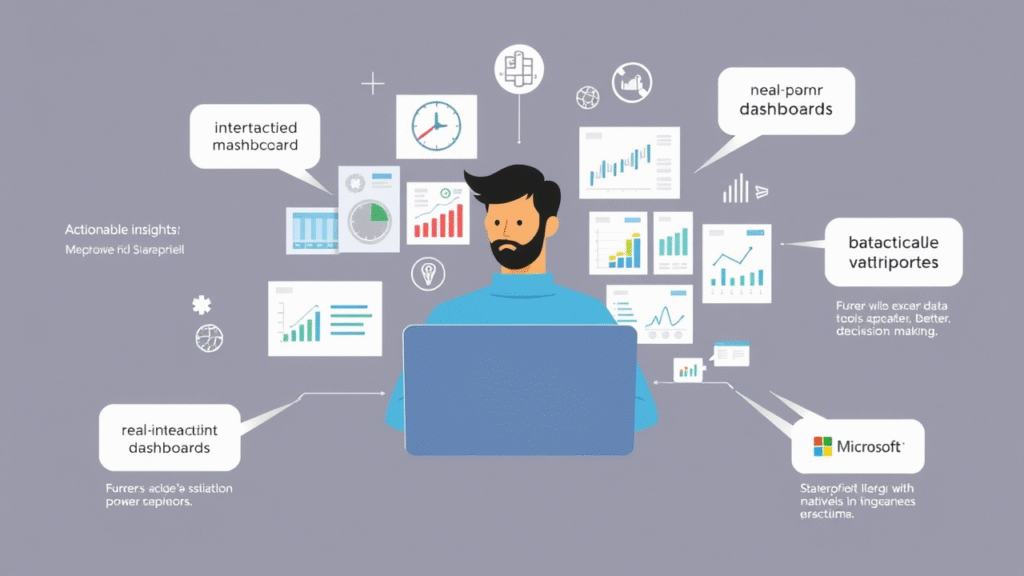
Power BI Pro supports custom visuals and extensions developed by the community and Microsoft. Analysts can leverage these tools to create tailored visualizations that meet specific business requirements. For example, a geographic heatmap can highlight customer concentration in certain areas, while a funnel chart can illustrate the stages of a sales pipeline. These custom visuals empower analysts to present data in ways that are most relevant to their audience.
Key Points:
Tools to Highlight:
Power BI Pro integrates seamlessly with other Microsoft products, enhancing workflow efficiency. Features like exporting reports to Excel and embedding dashboards in SharePoint enable analysts to work within familiar environments while leveraging Power BI’s advanced capabilities. For example, a finance team used Power BI with Excel for budget planning, combining the strengths of both tools to create comprehensive financial models.
Key Points:
Tools to Highlight:
By mastering these top 10 Power BI Pro features, business analysts can unlock the full potential of the tool, driving better insights and decisions. From crafting dynamic dashboards and leveraging advanced reporting capabilities to harnessing AI-driven insights and ensuring robust security, Power BI Pro offers a comprehensive suite of tools to support data-driven decision-making.
Call to Action: Encourage readers to explore each feature further and experiment with Power BI Pro to see how it can transform their analytical workflows. Whether you’re new to data visualization or looking to deepen your expertise, Power BI Pro provides the tools you need to succeed.
Additional Resources: Suggest books, online courses, or tutorials for those looking to deepen their understanding. Some recommended resources include:
In today’s data-driven world, businesses rely on powerful tools to transform raw data into actionable insights. Microsoft Power BI Pro is one such tool that stands out for its ability to create stunning, interactive visualizations that drive decision-making. Whether you’re a business analyst, data scientist, or anyone working with data, Power BI Pro offers a robust platform to turn complex datasets into clear, engaging stories.
However, while many users are familiar with the basics of Power BI, unlocking its advanced features can be daunting. This guide aims to demystify the process and equip you with the skills to harness Power BI Pro’s full potential. By the end of this article, you’ll understand how to:
Let’s dive in!
Power BI Pro is more than just a data visualization tool—it’s a comprehensive business intelligence solution designed to help organizations make data-driven decisions. Here’s what sets it apart:
| Feature | Power BI Free | Power BI Pro |
|---|---|---|
| Real-Time Data Updates | Limited | Full Support |
| Premium Templates & Connectors | Basic Access | Full Access |
| AI Integration | Limited | Full Support |
| Data Refresh Frequency | Daily | Hourly/Real-Time |
| Row-Level Security | Not Available | Available |
Source: Microsoft Power BI Pricing
To begin your journey with Power BI Pro, you need to install Power BI Desktop and activate your Pro license. Here’s a step-by-step guide:
Power BI Pro supports a wide range of data sources, including Excel spreadsheets, SQL databases, Azure services, and more. Here’s how to connect:
Creating visually compelling dashboards is key to communicating insights effectively. Here’s how to get started:
Power BI Pro offers extensive formatting options to enhance the look and feel of your visuals:
Interactivity is what makes Power BI dashboards truly engaging. Here’s how to add it:
Tip : Reference industry best practices and case studies to inspire your design choices.
Power BI Pro offers advanced features that allow you to go beyond basic charts and graphs. Here’s how to leverage them:
DAX is a powerful formula language used to create custom calculations in Power BI. Here’s how to use it:
Conditional formatting allows you to highlight important data points dynamically. For example:
A retail company used Power BI Pro to create a dynamic sales dashboard. By implementing conditional formatting and DAX formulas, they were able to identify underperforming regions and optimize inventory management.
Real-time data is crucial for industries like finance, logistics, and manufacturing. Here’s how to set it up:
A financial firm uses Power BI Pro to monitor stock prices in real-time. By integrating live data feeds, analysts can make split-second decisions based on the latest market trends.

Handling large datasets efficiently is critical to maintaining a responsive and user-friendly dashboard. Here’s how to optimize performance:
Power BI Pro enables seamless collaboration across teams and organizations. Here’s how to share your dashboards effectively:
Row-level security allows you to control which rows of data a user can see based on their role or attributes. For example, a regional manager might only see data related to their region.
Even the most experienced users encounter challenges when working with Power BI Pro. Here’s how to troubleshoot common issues:
Power BI Pro has transformed countless organizations by empowering them to make data-driven decisions. Here are some success stories:
A leading retailer used Power BI Pro to analyze sales data across multiple stores. By integrating real-time data and leveraging advanced visualizations, they identified underperforming products and optimized inventory management, resulting in a 20% increase in profitability.
A healthcare provider implemented Power BI Pro to monitor patient outcomes and resource utilization. By creating interactive dashboards, they improved operational efficiency and reduced costs by 15%.
Now that you’ve learned the ins and outs of Power BI Pro, it’s time to put these skills into practice. Try building your own advanced dashboard using the techniques outlined in this guide. Share your experiences in the comments section below, and let’s learn from each other!
Power BI Pro offers enhanced features like real-time data updates, premium templates, AI integration, and advanced analytics, whereas Power BI Free has limitations in these areas.
Yes, Power BI Pro is designed to be user-friendly, but learning DAX can significantly enhance your capabilities.
The frequency depends on your data needs. For real-time insights, consider hourly or continuous updates; for less time-sensitive data, daily or weekly updates may suffice.
Yes, Microsoft offers free tutorials and courses on its official website, and platforms like YouTube and LinkedIn Learning also provide valuable resources.
Why This Matters:
By the end of this guide, you’ll understand why free activators aren’t worth the risk and discover reliable alternatives tailored to your needs.
Office 2024 activators are tools designed to bypass Microsoft’s licensing system, allowing users to “unlock” the software without paying for a legitimate license. These tools are often marketed as free alternatives to expensive subscriptions, but they come with severe drawbacks.
How Microsoft’s Activation Process Works (Legitimately):
Microsoft requires users to activate Office using a product key or subscription. This ensures users comply with licensing agreements and receive updates, security patches, and customer support.
Why Free Activators Are Different:
Key Takeaway:
Legitimate alternatives like Microsoft 365 subscriptions or free office suites (e.g., LibreOffice) provide the same functionality without the risks.
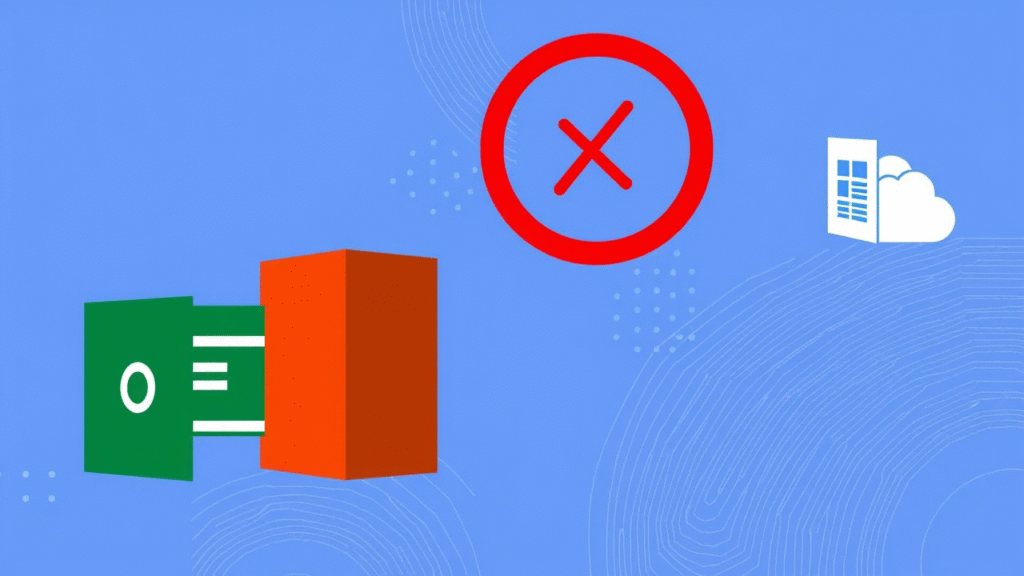
Using a free activator violates Microsoft’s End User License Agreement (EULA) , which explicitly prohibits bypassing activation.
Why It Matters: Legal repercussions extend beyond fines—your reputation and business relationships could suffer.
Free activators often come bundled with malware , including:
Data to Back This Up:
A 2023 report by Symantec found that 85% of pirated software downloads contained malware , with Office activators ranking among the top sources of infection.
Real-World Impact:
In 2022, a healthcare provider using pirated Office tools lost patient data in a ransomware attack, costing them $1.2 million in recovery and legal fees.
User Testimonials:
On Reddit, one user reported losing years of work after an activator caused irreversible file damage. TechRadar’s forums highlight frequent compatibility complaints with newer Windows versions.
Option 1: Microsoft 365 Subscriptions
Why It’s Worth It:
Testimonial:
A small business owner noted, “Microsoft 365’s $7/month plan saved us from malware and gave us tools we couldn’t afford otherwise.”
Option 2: Volume Licensing for Businesses
LibreOffice
Google Workspace (Formerly G Suite)
Apache OpenOffice
Why These Work:
Microsoft offers heavily discounted licenses for:
How to Access:
Hidden Costs of Free Activators:
ROI of Legitimate Software:
Cost Comparison:
| Option | Annual Cost | Risks | Benefits |
|---|---|---|---|
| Free Activator | $0 | Legal, malware, data loss | None |
| Microsoft 365 Personal | ~$84/year | None | Security, updates, support |
| Google Workspace Free | $0 | None | Basic collaboration tools |
Why This Matters:
Legal activation ensures you’re protected by Microsoft’s terms and receive ongoing support.
Free Office 2024 activators may seem like a quick fix, but they expose you to legal, security, and functional risks that far outweigh any savings. Legitimate alternatives like Microsoft 365, Google Workspace, or LibreOffice offer robust tools at affordable prices while keeping your data safe.
Your Next Steps:
Call to Action:
Don’t risk your data or your livelihood. Visit Microsoft’s official site today or explore free alternatives like LibreOffice. Your productivity—and peace of mind—are worth it.

In today’s fast-paced digital world, Microsoft Office remains one of the most essential tools for productivity. Whether you’re working on documents, spreadsheets, or presentations, Office 2024 offers robust features designed to streamline your workflow. However, even the best software isn’t immune to hiccups, and activation problems can disrupt your workday. This article will guide you through five practical solutions to address common Office 2024 activation problems. By the end, you’ll know exactly how to resolve these challenges and get back to focusing on what matters most—your work.
One of the most frustrating experiences when using Office 2024 is encountering activation errors. These issues can occur due to various reasons, including expired licenses, mismatched product keys, or server connectivity problems. Let’s explore some of the most common causes of activation errors and why they happen.
Activation errors in Office 2024 often stem from issues such as
According to statistics from Microsoft support forums, nearly 30% of users experience activation-related problems at least once every six months. Some of the most frequent error messages include
Microsoft’s official documentation outlines several troubleshooting steps for resolving activation errors. Additionally, user testimonials from community forums like Reddit and Quora highlight common frustrations and potential fixes shared by other users.
The first step in addressing activation issues is ensuring that your product key is valid. Here’s how you can verify your key and ensure it hasn’t been used elsewhere.
To locate your product key, check the following locations:
Once you’ve located your key, follow these tips to ensure it hasn’t been used elsewhere:
According to user feedback, manually validating keys has a success rate of around 75%, while automated tools tend to resolve issues more effectively. This discrepancy highlights the importance of using official resources for verification.
If your product key is valid but activation still fails, resetting your Office installation might help. Corrupted settings or files can interfere with the activation process, causing repeated crashes.

Resetting your Office installation involves repairing corrupted settings without losing your data. Here’s how you can do it:
Statistics show that repair attempts have a higher success rate (around 85%) compared to full reinstallation, which has a success rate of approximately 70%. This makes repair a more efficient first step when dealing with activation issues.
When DIY fixes fail, reaching out to Microsoft experts is often the best course of action. Professional support can provide tailored solutions to your specific activation problems.
Contacting Microsoft support is crucial for persistent issues. Here’s how you can reach out:
Case studies from Microsoft’s support team reveal that many users receive effective solutions within just a few hours of initiating contact. This highlights the value of leveraging professional expertise when dealing with complex issues.
Outdated versions of Office can sometimes conflict with activation servers, leading to persistent activation problems. Ensuring compatibility with the latest features and fixes is critical.
Updating Office directly from the app is a straightforward process. Here’s how you can update your software:
Microsoft’s release notes often include detailed information about recent bug fixes related to activation. Staying updated ensures you benefit from the latest improvements and security patches.
If traditional licensing methods continue to pose challenges, consider alternative subscription-based models like Office 365 or Office 2024 subscriptions. These models offer seamless activation and additional benefits.
Subscription plans like Office 365 provide numerous advantages over traditional perpetual licenses. Here’s why switching might be beneficial:
Conversion rates among users transitioning from perpetual licenses to subscriptions indicate a growing preference for subscription models. Signing up for a monthly or yearly subscription plan is simple:
While activation problems in Office 2024 can feel frustrating, they are often solvable with the right approach. From validating your license to leveraging expert support, this guide provides actionable steps to restore functionality quickly. Remember, staying proactive—like keeping your software updated—can prevent future headaches. Happy working!
Don’t let activation issues derail your productivity. Try these solutions today and take control of your Office experience. If you’ve encountered similar issues, share your experiences in the comments below. Your insights could help others facing the same challenges!

keyswholsale©2024 . All Rights Reserved. Designed by keyswholsale.com
Select at least 2 products
to compare